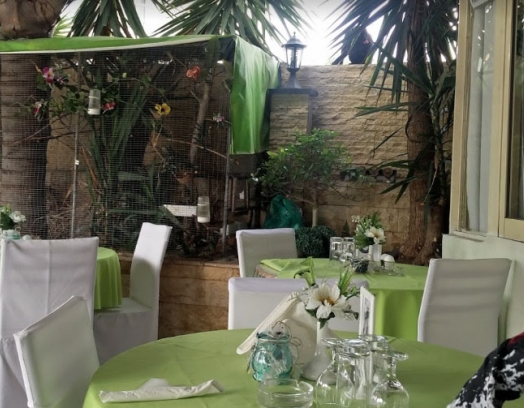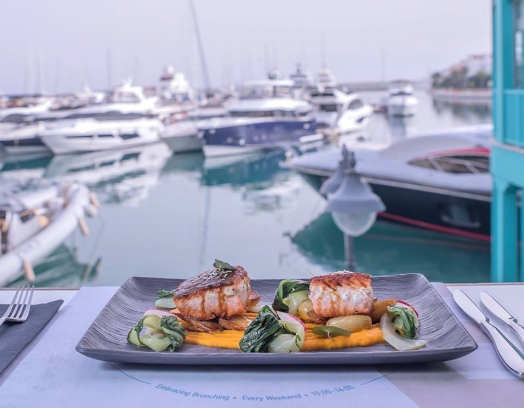The extraction, treatment and trade of copper have long been a valuable export commodity for the island. Together with their acquired skills and experience accumulated while working with this metal, local craftsmen — blacksmiths, tinsmiths and coppersmiths — who for centuries had served the everyday needs of the population’s different classes, passed on, from generation to generation, the secrets and skills of metal processing. Today, Cyprus takes pride in this legacy and attempts to preserve it, striving to develop this ancient tradition in the conditions of the modern material world.
In the Bronze Age (2500-1050 B.C.), close to 2400 B.C., residents from the Anatolian peninsula first came to Cyprus, followed by settlers from Crete and then Mykonos. Greek colonists (The greatest of whom were Kings Teucer and Agapenor, the founders of Salamis and Paphos) brought with them language, art and religion.
Cyprus (or Alasia, as it was named in the second half of 2 B.C.), was the country with the largest copper deposits and therefore a copper manufacturer in the Eastern Mediterranean. Alasian ships would leave for the East and West, loaded with metal smelted in the form of ox hides, weighing 25 and 40 kg. Evidently, for this reason, one of the “symbolic” and most famous artefacts of that time is the so-called warlike “horned idol”, from the polis of Enkomi: it’s composed of a bronze statuette in a helmet crowned with horns, who is standing on an “ox hide” (see our review for more details).
These words are contained in a collection of clay tablets known as the “Amarna Letters” — a genuine archive of diplomatic correspondence from the Pharaoh of Egypt between other rulers in the region and his deputies, including those located in the Eastern Mediterranean. The artefact, which dates back to the year 1375 B.C., was discovered in the late 19th century. In fact, in the late Bronze Age (15-11 B.C), Enkomi was the centre for copper trade — the primary source of wealth for the island.
Miniature models of chariots, thrones, tables, trays for large vessels etc. — these were amongst the various copper objects found. The detail of their finishing is almost of a jeweller’s standard; the execution and realistic appearance of the work can not fail to be admired. Bronze pins with round tops made of lustre (an imitation of mother-of-pearl) also date back to this period. There are also human (standing and sitting) and zoomorphic figures, crafted somewhat schematically, which originated in XII B.C., from Kalavasos and Pila. During excavations of the site where the settlement of Ma once lay, ancient bronze scales and weights were also found from XII B.C.
Incidentally, you can encounter spear tips, bronze arrows, knives, crop farmers’ tools and nails etc. (all from the Late Bronze period) in many museum collections on the island and other countries.
In the royal tombs of Salamis, which lay directly by Enkomi, magnificent samples of copper items were also discovered, for instance: an elegant bed, inlaid with ivory and coloured glass; two thrones and a bronze cauldron mounted on an iron tripod and decorated around the edge with busts of four sirens and eight gryphons.

The Iron Age arrived (1050-475), and after the destruction of Cyprus and its once prospering cities through the course of natural cataclysms, a different, new era began. Around 900 B.C., the island witnessed the arrival of the Phoenicians, who had founded a well-established state, with its centre in Kition (now modern-day Larnaca). This followed the appearance of the Assyrians, who were responsible for the obelisk of Sargon II (which currently resides in the Berlin Museum).
The period from VIII-VI is considered the golden age for the island. The Assyrians were replaced by the Egyptians, who were, in turn, succeeded by the Persians. They all introduced a part of their culture (both material and spiritual) into that of Cyprus.
It’s worth noting that the majority of small plastic arts, fashioned from bronze, belong to somewhere between the archaic (VII-V B.C.) and classic period, which reached its heyday in 400-325 B.C.
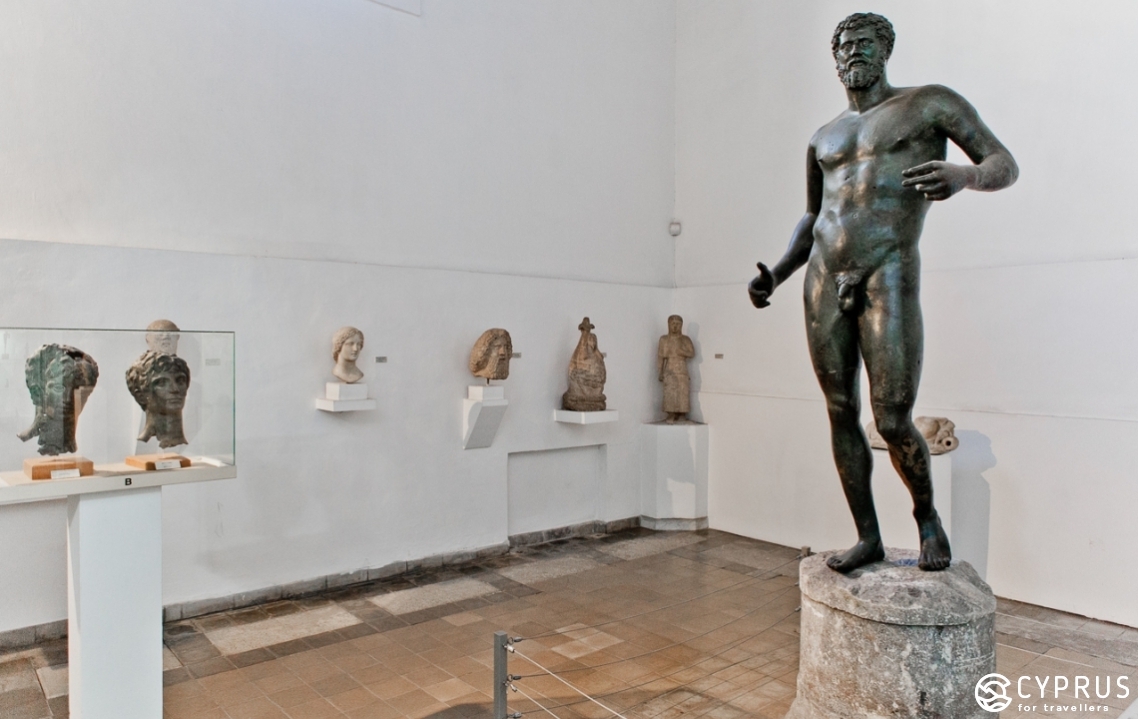
The Greco-Roman period (50 B.C. - 395 A.D.) descended and with it came the heyday of bronze sculpture work (which, along with marble statues, appeared in great abundance). A monumental work of art from those years, for instance, is the most celebrated bronze statue of the Roman Emperor (193-211 B.C.), Septimus Severus. It was crafted from bronze, with an interesting story linked to its materialisation. Like in many other Roman provinces, the cult of the Emperor, who was revered alongside the local pantheon, was widespread across Cyprus. The Emperor was initially considered by researchers to have held a shield and spear and his hands.
In 1928, a statue was discovered by a villager working in a field not far from Kythrea. When it eventually reached the museum employees, it appeared to have suffered a fair amount… not so much from time, but the hands of that same villager, who had tried to attain the “treasures” inside.
The famous bronze head of Zeus Ammon (with inserted “eyes” and other silver elements, 300-200 B.C.) is also very expressive and realistic.
-
Aside from their applications in sculpture work and the crafting of luxury items, metals were also used for other needs (artisans have long been adept at working with metals in different spheres of community life).
With changes in foreign rulers came new trends and material possessions to the island: this has been superbly tracked in the development of monetary units.
Coin Minting
Let’s say several words on this. Thanks to its beneficial location, Cyprus, in various ages, has continually been involved in the intensive economic processes of the region. All of its numerous invaders and rulers (the Assyrians, Egyptians, Persians, Romans, Francs, Byzantines, Venetians, Turks and Brits) have sought to use the island as a centre for trade with other countries. These processes, which are reflected in Cypriot numismatics, can be analysed in depth upon visiting the exhibition at the Numismatics Museum, part of the Cultural Foundation of the Bank of Cyprus.
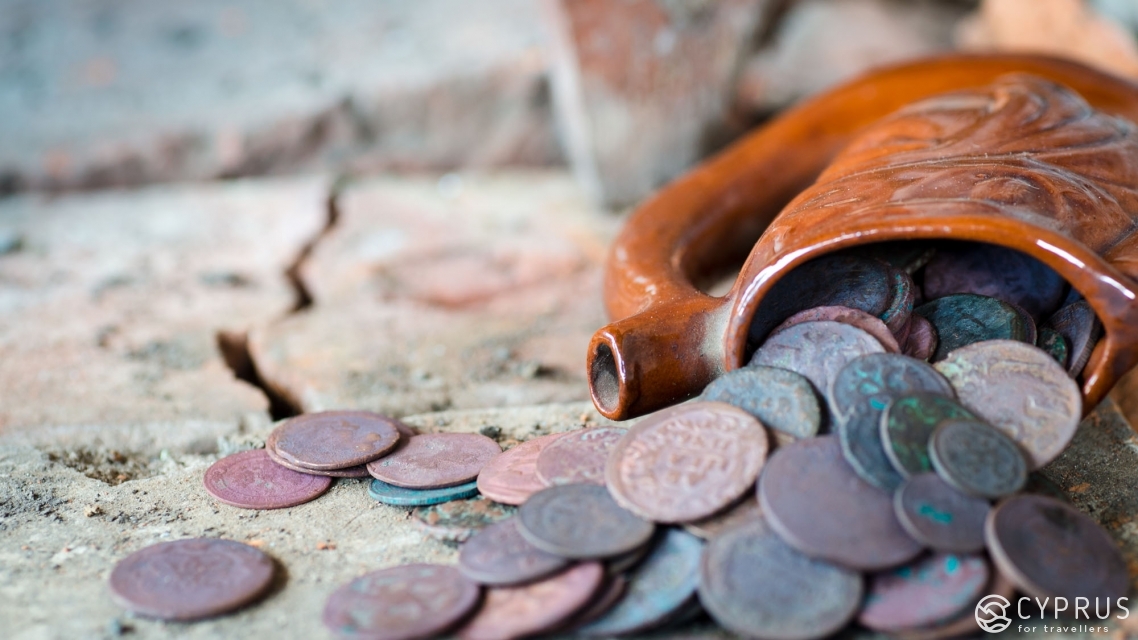
In short, this is how events unfolded. During Persian rule, silver Persian coins were minted on the island, but in 6 B.C. King Evelthon (560-525 B.C.), who had achieved political-economic independence in Cyprus, began to create his own coins: they were encountered, for instance, in ancient treasure troves discovered in Egypt and the Near East. Another king, Evagoras I (411-373 B.C), was the first ruler of the island, whose reign saw the appearance of money made from gold: his coins featured the image of Heracles and an inscription in the Cypriot dialect. The personal coins of individual rulers later appeared in other Cypriot kingdoms: Paphos, Kition, Amathus, Marion, Soli, Lapithos, Tamassos, Kourion and Idallion. Historians have noted that the ancient states of Cyprus, in this respect, were significantly ahead of Phoenicia and Cilicia.
After joining forces with Alexander of Macedon, the Cypriot kings manufactured their own money on rare occasions, since the local mints were under the control of Alexander’s governors and produced his coins. Reign over Cyprus was later transferred to Ptolemy I, whose monetary system complied with a new policy: metals used for the manufacture of foreign currency units were to come from local mines. The coin faces of that period depicted Ptolemy I himself, while the reverse image featured an eagle with the aegis of Zeus.
Under Roman rule, the island turned into a province of the Empire, subsequently accepting its monetary system.
Money in circulation on the island during the Byzantine period, which began in 330 A.D., originated from the coin vaults of Constantinople and other cities, with the exclusion of those coins minted on the island in the 7th century.
The year 1191 witnessed the arrival of the English King, Richard the Lionheart, who seized the island and later sold it to the Order of the Templars. He, in turn, sold it to the usurped King of Jerusalem, Guido de Lusignan, the founder of the Franko dynasty. Coins from this period (until 1284 A.D.) were minted in a convex, rounded shape.
Under Henry II (1284-1324) a new silver coin appeared — the gross, which remained as the official denomination of the Cypriot kingdom right until the reign of the Lusignan dynasty came to an end. These coins had a crusades-oriented “theme” (crosses, allegorical figures etc.). The minting of coins was administered by royal decree, but circulation of the local currency was permitted throughout the country only. When foreign money appeared, it would be melted and refined into the local “currency”.
The last units of currency issued in the Lusignan kingdom (1474-78) are attributed to the reign of Catherine Cornaro (mainly lead coins survived to the present day). Later, when Cornaro was forced to transfer control of the island to Venice, minting coins in Cyprus ceased: nor was it renewed under the Turks or British.
After a long absence, the first Cypriot units of currency appeared in 1963, in the Republic of Cyprus: they were the same value as their British counterparts, but with their own, unique emblem engraved. The national currency was in circulation until late 2007 (it had already been replaced by the Turkish Lira in the occupied Northern territories). Transfer to the Euro took place on 1st January 2008.
The Works of Cypriot Coppersmiths
Nowadays, as in the past, an artisan of the “copper island”, while performing the rhythmic process of engraving, creates a variety of objects from sheet metal: vessels, pots and dishes. Their shape and decor is often copied from antique samples, or carries images originating from ancient mosaics or frescos… Glinting sides, crafted from metals of a polished red or matt silver colour, with copper rivets installed. They vary in shape and usually have a rounded body, with a nose, or a long “neck”. If not in the city markets, you can find all these utensils today in workshops or at village fairs.
Surprising as it may seem, the expertise of coppersmiths is still in high demand to this day: Cypriots today, not always for practical, but more aesthetic purposes, make multiple orders for this type of design. But let’s not forget the “cult” item for any island resident — a thin, rather exquisite “mbriki” — a coffee maker widely on sale in both the island’s workshops and souvenir shops.

In the Antiquity, the most common forms of household utensils crafted from copper and different alloys, were dishes and jugs — nowadays, you can encounter them en masse in museum collections. In the medieval era, bronze was commonly used to manufacture different items.
The Ottoman period (1571-1878) introduced Eastern influences, although the life and practices of everyday inhabitants didn’t make a marked change. This contrasted with the representatives of the upper and affluent classes [1], who had the opportunity to receive education abroad or open their own businesses on the island. As in olden times, bazaars were the focal point for the lives of artisans, villagers and housewives: the traditional household utensils and items which we can see today on display, for instance, at the Leventis Municipal Museum, never fail to draw our attention. We can also note the appearance of delicate works such as lamps and bottles, etc., covered with black, gliding, inlays, or with an engraved pattern.
Since copper obtains a high level of pliability after consecutive heating and immersion in cold water, it has been used from the very beginning as an essential material in the manufacture of necessary kitchenware. After all, those same pots used to distil zivania were also produced from copper; in addition to saucepans, trays, buckets and church objects etc.
Now often heavily damaged, with significant losses to their appearance, they survive as exhibits, lying behind glass display cases, here and there “patched with” lead riveting (the Limassol Castle, The Limassol Folklore Museum, the local history museum in Steni etc.).
You can sometimes come across rare and antique items (of an inferior condition), fashioned by the coppersmiths of the past, in the interiors of some old homes, still inhabited to this day.

You’re probably wondering: what about today, is copper still mined in Cyprus nowadays? Well, the only site still functioning on the island is the Skouriotissa mine, located 56 km from Nicosia, in the village of Katydata.
The village acquired its name in the medieval era from the two rivers flowing through it — the Karkotis and Setrakhos. It originally sounded like “Cattidata”, meaning streams flowing downwards). The church, built in the year 1870, on the remaining foundations of an even older church and dedicated to Saint John the Theologian, stands as the village’s main attraction.
The local copper mine has been in operation since ancient times (references have survived from the Roman era), yet remains the largest on the island and one of the oldest in the world! A fascinating museum is located in the immediate vicinity, dedicated to mining: according to unverified sources, the museum closes periodically.
In the early 20th century, a new chapter began in the history of the mine… that of the Cyprus Mines Corporation. It was initially an American mining company based in Cyprus, whose president, Charles G. Gunther, began actively prospecting in the area of Skouriotissa, in 1914, having learnt from ancient sources that the island was historically rich in copper [2]. He was also inspired by the used slag heaps observed in the vicinity, which had survived from the ancient Roman period. As such, from 1916 until the early 1970s, the mine belonged to the family of Colonel Seeley W. Mudd and the mining engineer, Phillip Wiseman. The mine was later sold to Amoco.
Initially, the mine struggled to “survive”, however, over time, ore extraction began to bring in profits. A large workforce of Turks and Greek Cypriots was hired, and so the settlement of Skouriotissa turned into a genuine centre for miners: many workers, together with their families, relocated to a town which would be considered modern even by today’s standards. Harvey Seeley Mudd claimed the experience he had amassed over the existence of the Cyprus Mines Corporation, was significantly influential in the emergence of a genuine boom in scientific research at his engineering college. In actual fact, the copper, which the departed moneymakers had tasked Cypriots with extracting from the mines, went directly to Nazi Germany for weapons manufacture, until the outbreak of the Second World War. The owners, who subsequently didn’t deny this fact, insisted that ceasing cooperation with the Nazis would not only have negatively impacted the mines but also have shaken the Cypriot economy — and so everything “favourably” coincided for conducting business.
In 1948, the mine witnessed the occurrence of several lengthy strikes, organised by the Pancyprian Federation of Labour and the Turkish-Cypriot trade unions. They were caused by low labour wages for workers, who despite all the profits, were struggling to support the upkeep of their families — almost two thousand people. As of 1955, the company was exporting one million tonnes of copper per year. The situation took a drastic turn after the 1974 Turkish invasion when a part of the company’s mines (for instance the Mavrovouni mine) remained on the other side of the “green line”.
In the present day, the operating mine — as well as its tailings and waste heaps, which have recently increased in the vicinity — are of particular concern to both ecologists and local farmers growing citrus fruits. Local villagers claim that citrus crop yields are falling as a result of dust contaminating the plantation, as well as high levels of heavy metal contained in fruits. A drop in the size and quality of the fruits has also been observed.
Knife Crafting — A Traditional Craft of Lapithos
The art of knife manufacture was a point of pride for its locals: widely renowned abroad (artisans had clients from many countries) and passed for centuries from generation to generation, the art flourished here, right until the catastrophe of 1974.
Lapithos knives, particularly pocket ones, were long reputed; they were sharp, with a characteristic pointed shape and especially in demand amongst the island’s butchers, who valued the knives for the strength of their steel. In fact, they were in circulation amongst representatives of many other professions: farmers, gardeners, hunters, manual and office workers in the city, — everyone was equally fond of them for their lightness and high quality.
Interestingly, Lapithos penknives were generally an “integral” accessory for male Cypriots until the recent past. What’s more curious is that the ladies of the island, from all classes, were not devoid of this passion! Why — that would be something worth finding out!
Lapithos knives were manufactured from high-quality steel and differed in shape depending on their purpose: they could be fashioned in a long, wide, curved or pointed style. The handle was crafted from wood, or the horns of a bull, ram or goat.
The blade of a pocket knife folded into the handle, and on the reverse side, there was a hole for hanging it on a trouser belt or attaching it to a shepherd’s handwoven sack.
Many “users” loved carving their names or any other pattern into the wooden or horn-made handles of their pocket knives, as this added an individual charm to them.
Blacksmith Work
The very same Lapithos was also the location for manufacturing types of scales, plumb lines, steelyard balances and a multitude of weights… as well as guns. You could find your own blacksmith in every city quarter. Not only was each one of them adept at crafting various tools, but they were also the local “jeweler”.
Blacksmiths manufactured an incredibly large variety of products, for instance, agricultural tools: hoes, picks, ploughs, sickles, shovels; hardware: horseshoes and nails, railings, locks, window latches and locks for doors and gates. They also produced household and church utensils, as well as work-tools: church crosses, forged gates and stairs, vessels, cauldrons, sieves, barbecues, oil lamps and chisels.
The village adepts also widely manufactured accessories and knives for tailors and upholsterers, barbers and hairdressers; also anchors for fishing boats.
Lapithos blacksmiths were renowned for manufacturing various forms of weaponry: guns, service (military) weapons, daggers, sabres and pistols.
Moreover, this area had long been famed for its weapons production. In the present day, it is difficult to say when the skill originated; the art of the village gunsmiths, however, flourished in the early 19th century.
Historical Fact: in 1821, Constantine Kanaris, a famous Greek admiral and national hero in the war for independence, resorted to an ingenious military stratagem: having anchored in the lagoon of Asprovrisi, close to Lapithos, he officially declared to the Turkish authorities in Cyprus that the aim of his visit was to lay to rest the bodies of sailors from a warship which had been shot down by the Turks. In actual fact, he had filled the empty coffins with Lapithian rifles and swords, which brought a lot of benefit to the Greeks in the fight against the Ottomans (1821-29).
For more on Lapithos and its traditions, please see here: www.lapithos.org.cy.
Our Master Class
I’ve just had a thought: it seems we haven’t offered you any exciting activities for a while, so today let’s try to make something with our hands, from a sheet of copper or dense foil (after all, in ancient times, soft, pure gold, was similar to foil),… following on in the footsteps of ancient engravers, so to speak, if our story has inspired you.
The making of such a souvenir would also be interesting for both children and adults.
Engraving and Imprinting
You’ll need:
- A sheet of foil: you can buy ready-made thick foil (it’s simpler and safer for little ones to work with), or use the aluminium from a can of cola.
- A Substrate: thick cardboard or rubber, plastic, or felt carpet. This way, our foil sheet won’t puncture or become deformed when we are working with tools. Please remember: the rougher the foil, the softer the substrate must be, while a thin sheet requires a stronger base.
- A Tool: a stick with a pointed end, to start with, better to choose the handle from a small brush or a chopstick.
- An illustration: absolutely any.
- Scissors.
- A ruler.
Place the foil face down onto the substrate: the image on the finished product, after all, will be obtained from the reverse side — “like with a mirror”. We then transfer the image: place it over and press the stick down along the outline, or immediately redraw the pattern on the foil with a marker and use the stick to “put pressure” on the sketch. The most important thing to remember is to work accurately to ensure the foil doesn’t tear.
Make a frame as you see fit: use the stick to draw a line along the ruler, making a small indent from the edges.
You can add an artistic finish to your obtained relief image: for instance, by adding colours in places to the prominent parts (let’s say, making the “flower petals” vivid, painting in a “butterfly’s wings”, shading the “scales of a goldfish” or the “eyes of a puppy”). You can frame the finished product with a cardboard backing, folding the edges of the foil sheet around it.
-
And now — a more serious task for “adults”… are you ready?
We’re going to have a go at engraving a sheet of copper, a technological process which is very popular today and one we’re very capable of completing. It’s good to know that your work — however simple it may be, to begin with — is all the same, an exclusive and hand-made piece!
As was the case in times of old, the main tools of an engraver are a hammer and stamp. Aside from copper, the following will also be suitable for a base: brass, aluminium, nickel (alloyed with copper: German silver and nickel silver) and galvanised iron (for more “rugged” pieces). They can be bought in craft shops or shopping centres such as “Leroy Merlin”, or on construction markets (roof copper and iron).
The principle, by the way, is the same as when working with foil: all actions should be carried out using a substrate: you’ll need a piece of wood (a cross-section cut: birch, oak, lime).
You’ll further need to assess the thickness of your sheet: if it’s rather thin, then place a piece of felt or rubber over your wooden substrate. To create larger panels (more than 50 cm2), experts advise that you stock up on a tarpaulin sack filled with fine grain sand; for miniature items, professionals have a lead plate which allows them to achieve elegant, elaborate lines and strokes on the image.
To start with, it’s worth deciding the following: will you be making an engraving with high (3D effect) or low relief (openwork decor with a clean perforation).
You can initially try your efforts at engraving some household utensils or taking a tin can, used for tea or coffee, which you don’t need. The work here is a little simpler: firmly secure the “object” and apply the image using a pencil. Select a metallic object with a blunt end for future “engraving”, and get a hammer (around 200g in weight). Use light blows to outline your picture, after this — use a “light stroke of the hand” to fill in the background with small “points”.
Do you want to take on engraving seriously? Then it’s worth getting a professional kit:
- A kanfarnik (a chisel),
- А sharp chisel — for making perforated patterns,
- A screwdriver,
- A tool for glazing and levelling the panel base.
You also won’t make do without clamps, weights, a vice and а kiyanka — a wooden mallet.
-
Now we’ll explain how to engrave copper “along a sheet”.
Several masters heat the copper beforehand: this makes the material more pliant. Others, who experiment with the artistic properties of the metal, scorch the copper sheets completely, achieving an “abstract”, blackened pattern on the surface.
So, now armed with your sheet of copper and an image on paper, you’ll first need to transfer the pattern to the copper: take a piece of plasticine and “roll” it over the surface of the metal. This “greasy layer” will allow the tool to slide more easily. Then lay down the carbon paper and place the sheet and image over it; go round the image. Work over the image with a chisel and along the outline.
Some advice from the pros: buy a turntable for the long run, so you’re not running in circles when you’ve set your sights on a large scale masterpiece.
Then, as we’ve already discussed, fill in the background by tapping lightly on the engraving.
Please Note: So they are able to forge the background more quickly and devote all their attention to the artistic finishing of the main details, old-school adepts even fashion machines of their own design — in the vein of a “sewing machine” (they, for instance, were used everywhere by soviet craftsmen. For 25-30 years ago, as many recall, the USSR was “engraving everything and everywhere”. There was a massive trend of decorating home interiors with engraved “pictures”, crafted by skilled craftsmen from Russia, Georgia, Azerbaijan and other republics).
Don’t forget to “spread” the main pattern over the background: after applying all the contour lines, accounting for the metal’s pliability.
You can immediately “fit” your future panel into the frame: outline it with a ruler, leaving a 0.5-1 cm indent from the edge (a unique tool “a spiked wheel” will be of help here). The frame obtained will be embossed on the reverse side. You can leave the background as it is, or perforate it with another tool.
In general, turn the piece over often, to get a feel of the image you’re making and where it needs more work.
You can varnish the finished piece if you wish.
Until Next Time!
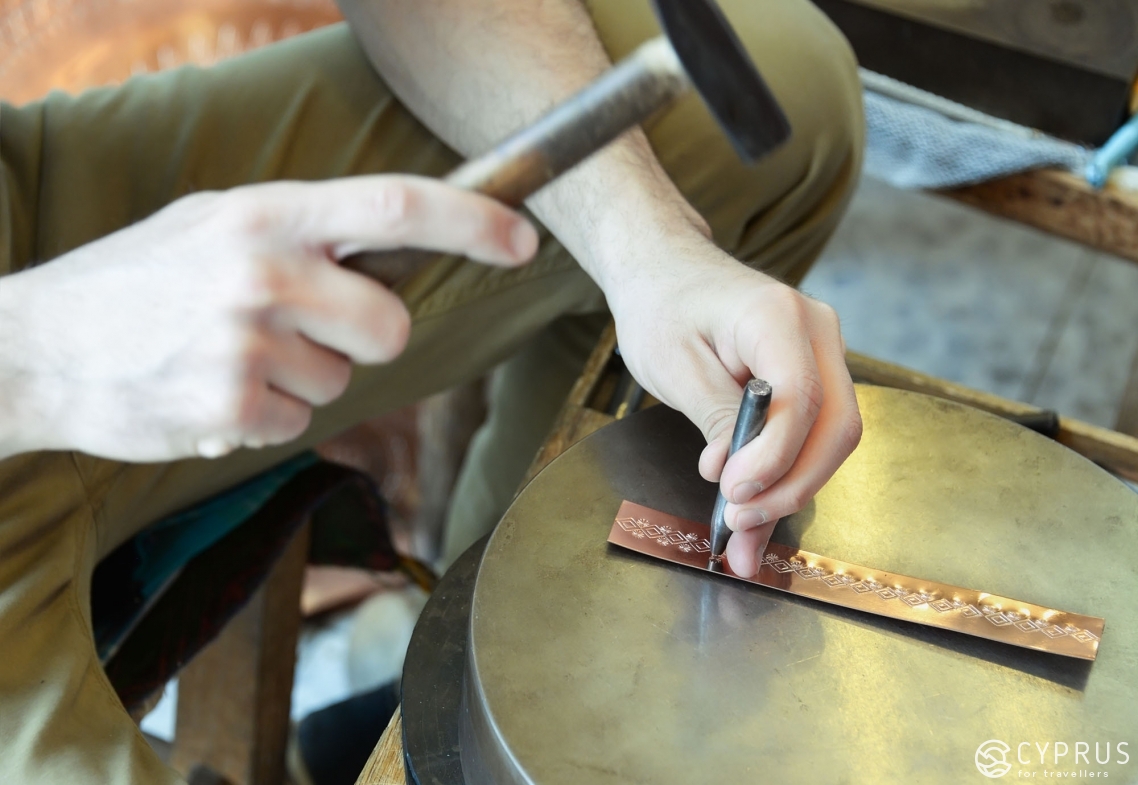
[1] There is no better illustration of this than in the Museum collection at The Hadjigeorgakis Kornesios Mansion and directly in the history of the dragoman himself
[2] Along with the Skouriotissa copper mine, the following regions were also prospected: Tamassos, Kambia, Kalavasos and Limni. A total of 30 copper deposits were concentrated there. Incidentally, several isolated deposits were discovered in the districts of Mangaleni in Limassol and Troulli in Larnaca, as well as Pera Vasa and Vretsia in Paphos.






